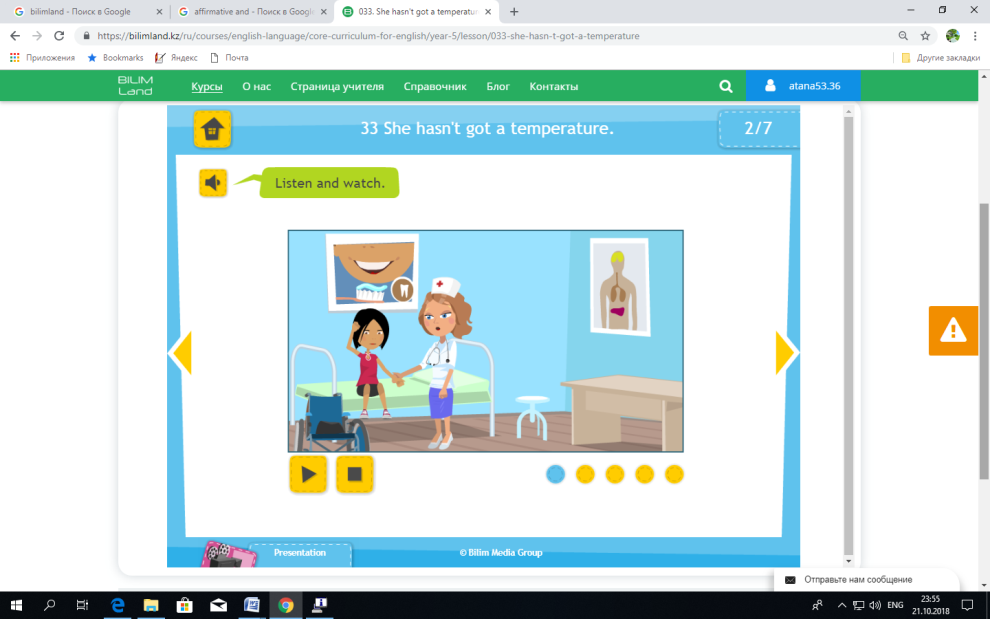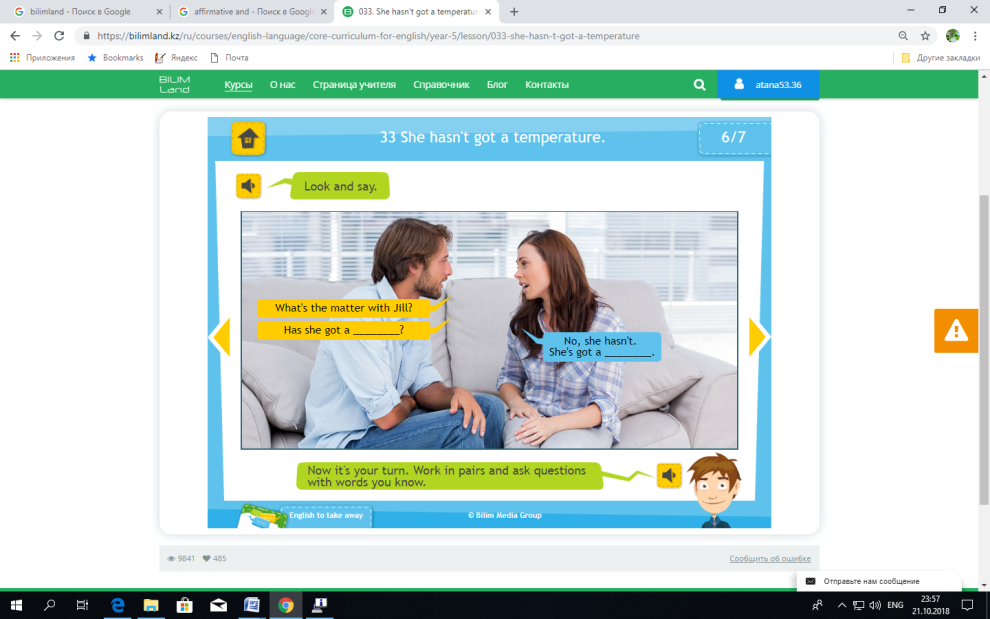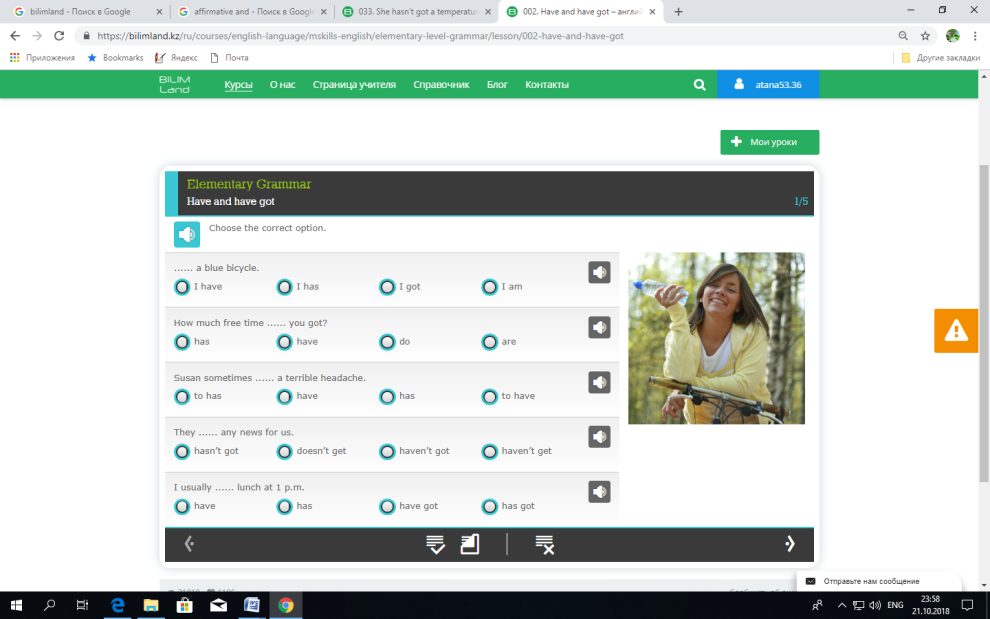
Short term planning (Lesson 15)
|
School-lyceum No53 |
UNIT TWO “Living Things” |
||||
|
Grade: 5 |
Teacher’s name: Kussepova G.T. |
||||
|
Theme of the lesson: |
Have got p.23-24 |
||||
|
Learning objectives(s) that this lesson is contributing to |
5.UE 3 use a growing variety of adjectives and regular and irregular comparative and superlative adjectives on a limited range of familiar general and curricular topics |
||||
|
Lesson objectives |
All learners will be able to:
Most learners will be able to:
Some learners will be able to:
|
||||
|
AssessmentCriteria |
The students achieve the lesson objectives if they
|
||||
|
Level of thinking skills |
Higher order thinking skills |
||||
|
Value links |
To bring up being responsible for care of environment and people |
||||
|
Cross curricular links |
Environment |
||||
|
ICT skills |
Bilim Land |
||||
|
Intercultural awareness |
Students will be able to differentiate ‘have got/ has got’ and understand the differences between cartoon characters and people |
||||
|
Kazakh culture |
Students will be able to differentiate values in Kazakh culture and traditions related to the nature |
||||
|
Pastoral Care |
Students will be able to understand the importance of respecting values |
||||
|
Health and Safety |
Everyday classroom precautions will ensure that safety measures are provided to prevent the exposure of electrical power cords |
||||
|
Previous learning |
Parts of Body. |
||||
|
|
|||||
|
Planned timings |
Planned activities |
Resources |
|||
|
Beginning 2-3 minutes Brainstorming 2-3 minutes |
Class organisation Teacher introduces learning and lesson objectives Students write the date, day and lesson objectives into their copybooks. Game Match the sentences with pictures
|
Pictures |
|||
|
Middle 30 minutes 5-7 min 18-20 min 5 min |
To present the verb ‘have got’ • Ss close their books. Present the verb have got. Ss click the link and open BilimLand, where they have tasks from Presentation till Lesson to take away. Point to the first button and ask students to get introduced with the information. Then write it on the board. Repeat using the the affirmative forms. She has got a temperature. She has got a cold. She has got a headache. Drill Ss. Give prompts. Ss make negative form using above-mentioned sentences. She hasn’t got a temperature. She hasn’t got a cold. She hasn’t got a headache. Point to the sentence structure and ‘n’t’, explain that ‘n’t’ is the shortened form of not. Write the interrogative form on the board and underline Have …got? Give examples in all forms. Point to a S and ask Has she got a temperature? Yes, she has / No, she hasn’t
To practise the verb ‘have got’ Explain the task and point out the rules and tasks. Allow time for Ss to complete the task. Check Ss’ answers. Ss watch, read and listen to consolidate the material. Practice
To practise speaking Explain the task. Ss compile a dialogue. Monitor the activity around the class and then ask some Ss to share their sentences with the rest of the class.
Consolidation Ss. Consolidate their knowledge and check how well they acquire the lesson and grammar rules. Teacher can note their mistakes on report cards of the learners.
|
https://bilimland.kz/ru/courses/english-language/core-curriculum-for-english/year-5/lesson/033-she-hasn-t-got-a-temperature https://bilimland.kz/ru/courses/english-language/mskills-english/elementary-level-grammar/lesson/002-have-and-have-got
|
|||
|
End 5 minutes
|
Homework: W&GB ex 1-2
Teacher asks learners 1) Can you write what you have got? 2) Can you write what you haven’t got? 3) Can you ask what your friend has got? Feedback (I) |
Evaluation sheet |
|||
|
Additional information |
|||||
|
Differentiation – how do you plan to give more support? How do you plan to challenge the more able learners? |
Assessment – how are you planning to check learners’ learning? |
Cross-curricular links |
|||
|
|
|
|||
|
Summary evaluation What two things went really well (consider both teaching and learning)? 1: 2: What two things would have improved the lesson (consider both teaching and learning)? 1: 2: What have I learned from this lesson about the class or individuals that will inform my next lesson? |
|||||
жүктеу мүмкіндігіне ие боласыз
Бұл материал сайт қолданушысы жариялаған. Материалдың ішінде жазылған барлық ақпаратқа жауапкершілікті жариялаған қолданушы жауап береді. Ұстаз тілегі тек ақпаратты таратуға қолдау көрсетеді. Егер материал сіздің авторлық құқығыңызды бұзған болса немесе басқа да себептермен сайттан өшіру керек деп ойласаңыз осында жазыңыз
Unit 2 Living things. Have got p.23-24
Unit 2 Living things. Have got p.23-24
Short term planning (Lesson 15)
|
School-lyceum No53 |
UNIT TWO “Living Things” |
||||
|
Grade: 5 |
Teacher’s name: Kussepova G.T. |
||||
|
Theme of the lesson: |
Have got p.23-24 |
||||
|
Learning objectives(s) that this lesson is contributing to |
5.UE 3 use a growing variety of adjectives and regular and irregular comparative and superlative adjectives on a limited range of familiar general and curricular topics |
||||
|
Lesson objectives |
All learners will be able to:
Most learners will be able to:
Some learners will be able to:
|
||||
|
AssessmentCriteria |
The students achieve the lesson objectives if they
|
||||
|
Level of thinking skills |
Higher order thinking skills |
||||
|
Value links |
To bring up being responsible for care of environment and people |
||||
|
Cross curricular links |
Environment |
||||
|
ICT skills |
Bilim Land |
||||
|
Intercultural awareness |
Students will be able to differentiate ‘have got/ has got’ and understand the differences between cartoon characters and people |
||||
|
Kazakh culture |
Students will be able to differentiate values in Kazakh culture and traditions related to the nature |
||||
|
Pastoral Care |
Students will be able to understand the importance of respecting values |
||||
|
Health and Safety |
Everyday classroom precautions will ensure that safety measures are provided to prevent the exposure of electrical power cords |
||||
|
Previous learning |
Parts of Body. |
||||
|
|
|||||
|
Planned timings |
Planned activities |
Resources |
|||
|
Beginning 2-3 minutes Brainstorming 2-3 minutes |
Class organisation Teacher introduces learning and lesson objectives Students write the date, day and lesson objectives into their copybooks. Game Match the sentences with pictures
|
Pictures |
|||
|
Middle 30 minutes 5-7 min 18-20 min 5 min |
To present the verb ‘have got’ • Ss close their books. Present the verb have got. Ss click the link and open BilimLand, where they have tasks from Presentation till Lesson to take away. Point to the first button and ask students to get introduced with the information. Then write it on the board. Repeat using the the affirmative forms. She has got a temperature. She has got a cold. She has got a headache. Drill Ss. Give prompts. Ss make negative form using above-mentioned sentences. She hasn’t got a temperature. She hasn’t got a cold. She hasn’t got a headache. Point to the sentence structure and ‘n’t’, explain that ‘n’t’ is the shortened form of not. Write the interrogative form on the board and underline Have …got? Give examples in all forms. Point to a S and ask Has she got a temperature? Yes, she has / No, she hasn’t
To practise the verb ‘have got’ Explain the task and point out the rules and tasks. Allow time for Ss to complete the task. Check Ss’ answers. Ss watch, read and listen to consolidate the material. Practice
To practise speaking Explain the task. Ss compile a dialogue. Monitor the activity around the class and then ask some Ss to share their sentences with the rest of the class.
Consolidation Ss. Consolidate their knowledge and check how well they acquire the lesson and grammar rules. Teacher can note their mistakes on report cards of the learners.
|
https://bilimland.kz/ru/courses/english-language/core-curriculum-for-english/year-5/lesson/033-she-hasn-t-got-a-temperature https://bilimland.kz/ru/courses/english-language/mskills-english/elementary-level-grammar/lesson/002-have-and-have-got
|
|||
|
End 5 minutes
|
Homework: W&GB ex 1-2
Teacher asks learners 1) Can you write what you have got? 2) Can you write what you haven’t got? 3) Can you ask what your friend has got? Feedback (I) |
Evaluation sheet |
|||
|
Additional information |
|||||
|
Differentiation – how do you plan to give more support? How do you plan to challenge the more able learners? |
Assessment – how are you planning to check learners’ learning? |
Cross-curricular links |
|||
|
|
|
|||
|
Summary evaluation What two things went really well (consider both teaching and learning)? 1: 2: What two things would have improved the lesson (consider both teaching and learning)? 1: 2: What have I learned from this lesson about the class or individuals that will inform my next lesson? |
|||||

шағым қалдыра аласыз





















